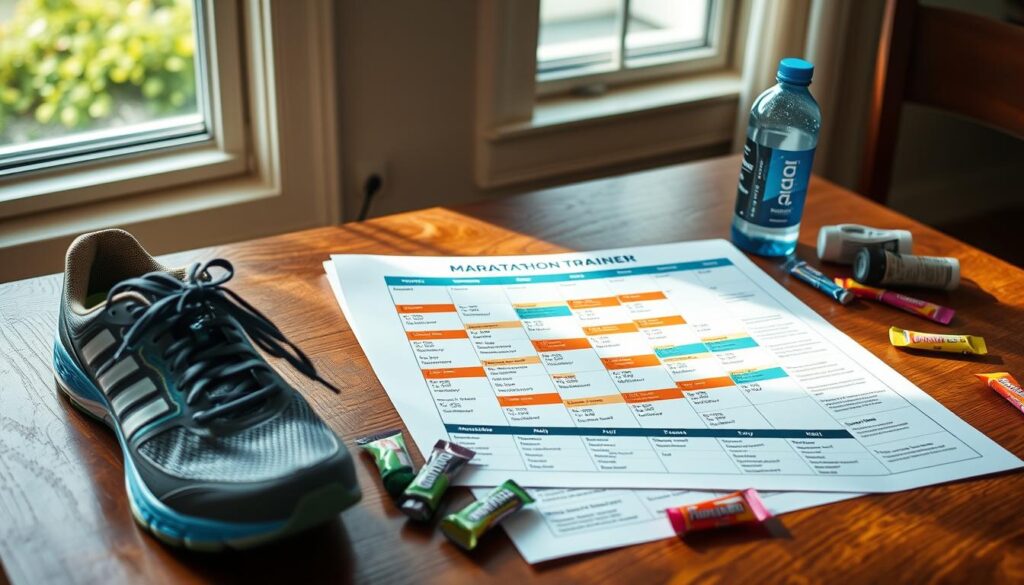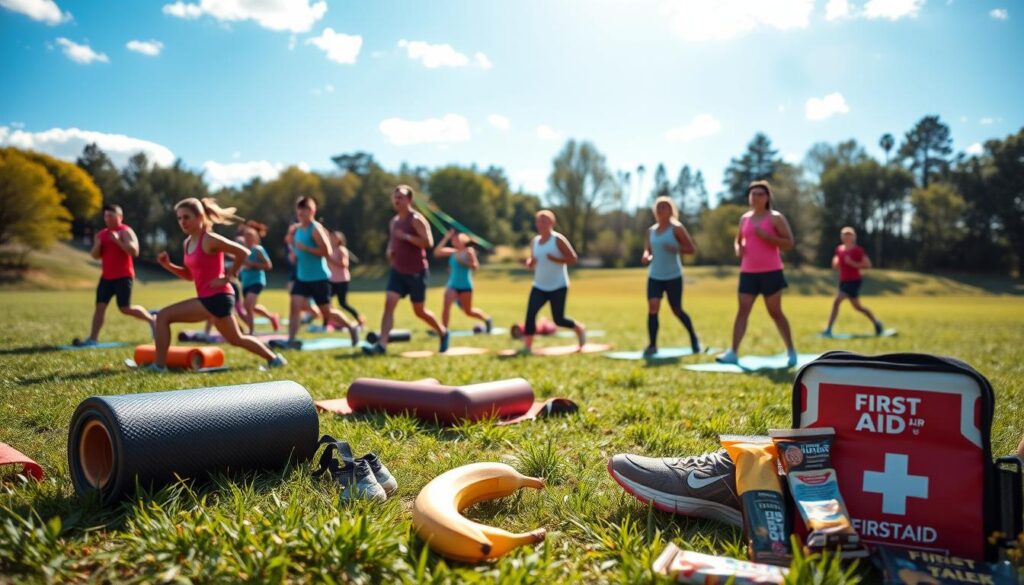Picture the thrill of crossing that finish line, the cheers of fellow marathon runners echoing in your ears as you reflect on every mile you conquered. Training for a marathon isn’t just about the physical demands of running 26.2 miles; it’s a journey that tests your determination, spirit, and resolve. Whether you’re a seasoned runner or embarking on your first running race, the emotional highs and lows are what shape your experience. There will be moments of disbelief when that long run feels impossibly challenging, but triumphantly, you’ll also enjoy the sweet taste of achievement after hitting a new personal best. With the right guidance and preparation, marathon training can become a fulfilling adventure rather than an overwhelming chore. Let’s dive into some essential advice that will not only prepare you physically but also mentally for the incredible challenge of marathon training.
Key Takeaways
- Training for a marathon requires both physical and mental preparation.
- Establish a routine that includes 4-5 runs per week and cross-training for support.
- Long runs should mimic race conditions, aiming for a steady pace.
- Adequate nutrition and hydration are crucial for performance and recovery.
- Reflecting on your journey enhances motivation and commitment to future goals.
Understanding the Marathon Journey
Embarking on the marathon journey involves understanding its profound history, diverse formats, and the inspiring cause of charity runs. Each aspect contributes significantly to the running experience, enriching your motivation and commitment.
The History of Marathons
The roots of marathon history trace back to the ancient Greek legend of Pheidippides, who ran from the battlefield of Marathon to Athens to announce victory. This legendary run symbolizes endurance and has shaped the modern marathon into a globally celebrated event. Today’s marathons gained popularity in the late 19th century, with thousands of participants celebrating sportsmanship and personal triumphs each year.
Different Types of Marathons
You may be surprised by the types of marathons available today. Depending on what you’re looking for, you can choose from:
- Road marathons
- Trail marathons
- Ultra-marathons
These types of marathons cater to various interests, whether you prefer city streets or rugged trails. Each format presents unique challenges and experiences for runners, making the marathon journey even more accessible.
Training for a Cause: Charity Runs
Many marathons offer opportunities for charity runs. Participating in these events allows you to support causes close to your heart while pursuing your personal running goals. Fundraising efforts embedded in marathon training create a deeper connection to your effort, fostering a sense of community and purpose. By running for charity, you contribute to meaningful causes while experiencing the emotional highs of marathon day.
Setting Realistic Marathon Goals
Defining your marathon goals forms the backbone of a successful training journey. Break your ambitions into manageable pieces to make the process rewarding and aligned with your abilities. Understanding the distinction between short-term and long-term goals plays a significant role in tracking your progress. A goal-minded mindset will keep you motivated through the challenges ahead.
Short-term vs. Long-term Goals
Establishing both short-term and long-term goals ensures a balanced approach to your training. Short-term goals might focus on achieving specific weekly mileage targets or completing a series of training runs successfully. Long-term goals encompass wider objectives, such as finishing the marathon or aiming for a desired time. For instance, if your current run pace indicates a 4:00 marathon, your long-term goal may shift to completing the race in the range of 3:45 to 3:50.
Tracking Your Progress
Incorporating a method to monitor your training helps maintain motivation and clarify improvement. You can use running apps or keep a training journal to track key metrics. Noting your times, distances, and paces enables you to see patterns, identify achieving milestones, and adjust your goals. This process aids in understanding how various workouts influence your overall fitness. For example, new runners may experience a 6-8% improvement over their training period, while those with more experience may only see 2-4% boosts.
Importance of a Goal-Minded Mindset
A goal-minded mindset significantly enhances your training experience. Focusing on the process rather than only outcome-based goals can alleviate anxiety linked to performance pressures. Experts suggest diversifying your goals—set a “C” goal as an attainable task, a “B” goal as a stretch, and an “A” goal as an ambitious target. This approach encourages resilience through challenges, fostering a motivation that will support you when obstacles arise during your marathon journey.

The Essential Gear for Marathon Training
Preparing for a marathon requires the right combination of gear, ensuring you stay comfortable and efficient throughout your training journey. With the right running shoes, marathon apparel, and essential running accessories, you can significantly enhance your performance and minimize injury risks.
Choosing the Right Running Shoes
Investing in a pair of quality running shoes tailored to your foot type is crucial. Brands like ASICS offer popular models such as the Novablast 3, which has been praised by elite runners like Sara Hall for its performance benefits. It’s important to replace your running shoes every 300-500 miles to maintain optimal support and comfort. Properly fitted shoes can reduce injury risks by up to 50%, making this a vital aspect of your training gear.
The Best Apparel for Comfort
Selecting the right marathon apparel greatly impacts your training experience. Look for moisture-wicking and breathable fabrics to enhance comfort during runs. Studies suggest that runners using such materials experience a 35% decrease in chafing incidents. Layering is key for adapting to changing weather conditions, especially since the average runner’s foot can swell during long runs. Light-colored clothing is recommended to minimize heat retention, particularly during summer training.
Must-have Accessories for Runners
In addition to shoes and clothing, consider incorporating essential running accessories into your gear. Hydration is critical, especially on longer runs. The Nathan Pinnacle 12L hydration vest can help maintain your fluid levels effectively, particularly over distances exceeding 16 miles. For tracking your progress, a smartwatch like the Garmin Forerunner 945 offers extensive metrics and up to a week of battery life with regular use. Other useful accessories include electrolyte replenishment options like SaltStick FastChews and GU Liquid Energy Gels to help combat dehydration and fuel your body during intense training sessions.

Creating a Training Plan
Designing an effective marathon training plan is crucial for success on race day. A well-rounded training schedule comprises various key components that help runners progress safely and efficiently. Understanding how to structure weekly runs and the role of cross-training will enhance your overall performance.
Key Components of a Training Schedule
Your training schedule should include essential elements such as long runs, speed workouts, and recovery runs. Each of these components plays a vital role in building both endurance and speed, ensuring preparedness as race day approaches. A typical marathon training plan spans 12 to 20 weeks, with most runners committing to around 16 weeks to fully develop their capabilities.
How to Structure Your Weekly Runs
Aiming for four to six runs each week creates a balanced approach that allows for gradual mileage increases. Start with a manageable base and aim toward a total weekly mileage buildup of at least 20 miles. As you progress, structure your weekly runs to include:
- One long run, gradually increasing from 10-12 miles
- Speed workouts, ranging from 4 to 8 miles
- Recovery runs of 3-4 miles at an easy pace
- Cross-training days to alleviate strain and promote overall fitness
The Importance of Cross-Training
Incorporating cross-training into your routine can significantly reduce the risk of injury while improving cardiovascular fitness. Activities like cycling, swimming, or yoga can serve as effective alternatives on rest days or in conjunction with weekly runs. This holistic approach helps maintain balance in physical training, supporting both strength and recovery throughout your marathon training journey.

Nutrition Fundamentals for Runners
Nutrition plays a vital role in your marathon training. Understanding how to fuel your body before, during, and after your runs can significantly enhance your performance and recovery. Emphasizing running nutrition can lead to improved energy levels and reduced fatigue. Let’s dive into the essential aspects of nutrition tailored for runners.
Pre-Run Meals: What to Eat
Before hitting the pavement, focus on consuming complex carbohydrates to ensure sustained energy throughout your run. Aim for a breakfast containing at least 100 grams of carbohydrates, ideally consumed 3 to 4 hours prior to your activity. Here are some excellent options:
- Oatmeal
- Bananas
- Whole-grain toast
Incorporating these foods into your routine will help fill glycogen stores, which typically last for approximately 60 to 90 minutes of running. If your runs exceed this duration, consider additional carb sources to maintain your energy.
Hydration Strategies During Training
Hydration strategies are crucial for marathon training. It’s recommended to drink about 6 to 7 ounces (180 to 210 ml) of fluid every 15 minutes, which equals approximately 24 to 28 ounces (720 to 840 ml) per hour. Monitoring your fluid intake will help prevent performance declines, as just a 1% reduction in body weight from fluid loss can negatively impact the effectiveness of your runs.
During longer training sessions, incorporate electrolytes to replace lost sodium. Most electrolyte tablets and sports drinks contain around 250 to 300 mg of sodium, helping you stay balanced. Familiarizing yourself with your specific hydration strategies during training runs will prepare you for race day.
Recovery Nutrition: Eating After a Run
Post-run nutrition is critical for recovery. Focus on meals that combine carbohydrates and protein in a ratio of 3:1 to replenish energy stores and support muscle recovery. Aim to consume something within 30 minutes of finishing your run, which is the optimal time to help your body repair.
| Food Item | Carbohydrates (g) | Protein (g) |
|---|---|---|
| Energy Bar | 20-40 | 5-10 |
| Gel | 21-27 | 0-1 |
| Banana | 24-30 | 1-2 |
Incorporating a balanced post-race meal will ensure that you are well-fueled for your next training session. Focusing on a solid recovery nutrition plan is essential for maintaining your training intensity and achieving your marathon goals.

Building Stamina and Endurance
Effective endurance training is essential for marathon success. Central to this is a balanced approach, incorporating long runs, interval training, and an awareness of your body signals. This section will explore these key elements to help you enhance your marathon preparation.
The Role of Long Runs in Training
Long runs play a vital role in your stamina building. Gradually increasing your weekly running time from 90 minutes to 240 minutes over a six-week period significantly enhances your body’s ability to adapt to marathon distances. Consider pacing at a tempo about 20% harder than your easy runs. Incorporating this into your routine fosters efficiency in endurance pacing, helping to prepare you for race day.
Interval Training: Boosting Your Speed
Incorporating high-intensity interval training (HIIT) is another effective strategy for improving speed. A suggested approach includes a work-to-rest ratio of 1:1, such as one minute of hard running followed by one minute of rest. This blend of intensity not only enhances your running economy but also elevates your aerobic capacity. Start with short bursts and increase your efforts progressively to optimize your training.
Listening to Your Body: Avoiding Overtraining
Being attuned to your body signals is critical in marathon training. Signs of fatigue, pain, or discomfort shouldn’t be ignored, as they indicate your body may need additional recovery. Ensuring adequate sleep, proper hydration, and balanced nutrition will also enhance muscle repair and overall performance. Your weekly structure should include one or two days of cross-training to improve cardiovascular endurance while minimizing injury risk.

| Training Element | Recommendation | Purpose |
|---|---|---|
| Long Runs | Increase time from 90 to 240 minutes | Build stamina |
| Interval Training | 1:1 work-to-rest ratio (HIIT) | Boost speed and endurance |
| Body Signals | Pay attention to signs of fatigue | Avoid overtraining |
| Cross-training | At least 1-2 days a week | Enhance endurance, reduce injury |
Mental Preparation for Race Day
Mental preparation plays a vital role in achieving your marathon goals. It can significantly enhance your confidence and help you navigate challenging moments, especially on race day. Utilizing various techniques allows you to harness your mind effectively, leading to a better performance.
Visualization Techniques for Success
Incorporating visualization techniques into your training regime is essential, particularly in the two weeks leading up to the marathon. Spend about 5 minutes daily visualizing race day scenarios. Imagine yourself confidently running the course, perfectly executing your race strategy. This mental rehearsal can elevate your preparedness and help manage any race day anxiety. In addition to visualization, consider incorporating the backwards training method for marathons into your preparation. This technique involves planning your training by starting from the finish line and working backward to determine your pacing and fueling strategies. By visualizing not only the race itself but also the various elements of your training, you will build a comprehensive mental framework that enhances your confidence and performance on race day.
Mindfulness and Running
Engaging in mindfulness during your training sessions allows you to focus on the present. As you run, concentrate on your breath, your surroundings, and your sensations. This practice can strengthen your mental resilience and decrease anxiety as race day approaches. Learning to accept and acknowledge any discomfort can lead to a more enjoyable race experience while reducing the perceived effort.
Coping with Race Day Anxiety
Feeling race day anxiety is typically normal, but managing it is crucial. Techniques to cope with this anxiety include practicing deep belly breathing, which can lower heart rates and diminish stress. Moreover, establishing personal routines, such as a warm-up ritual or essential pre-race affirmations, can help calm your nerves. Remember to trust your training, as many elite runners emphasize the importance of preparation in treating pre-race jitters.

| Technique | Description | Benefits |
|---|---|---|
| Visualization | Imagining race scenarios to boost confidence. | Enhances preparedness and reduces anxiety. |
| Mindfulness | Focusing on the present during runs. | Improves mental resilience and reduces discomfort sensation. |
| Deep Breathing | Inhaling deeply to calm yourself. | Lowers heart rates and helps manage race pressure. |
| Acceptance | Acknowledging feelings of anxiety. | Increases overall enjoyment of the race. |
Injury Prevention and Recovery
Engaging in marathon training brings notable challenges. You face risks, particularly related to injury. Statistically, nearly 50% of first-time participants in events such as the New York City Marathon develop a minor injury during their training period. Understanding injury prevention and effective recovery strategies is critical for maintaining your running routine and achieving your marathon goals.
Common Marathon Injuries and Solutions
As you embark on your marathon journey, awareness of potential injuries becomes essential. Common issues include:
- Runner’s knee (patellofemoral pain syndrome)
- IT band syndrome
- Plantar fasciitis
- Achilles tendonitis
- Stress fractures
Many injuries are related to overuse. With over 80% of serious injuries stemming from this cause, integrating injury prevention strategies is vital. Solutions include gradually increasing your weekly mileage by no more than 10% and incorporating strength training to target key muscle groups, especially hip stabilizers.
Stretching and Strengthening Exercises
Integrating dynamic stretching exercises before you hit the pavement prepares your muscles, while static stretches after your runs enhance flexibility. Effective routines include:
- Leg swings (dynamic)
- Hamstring stretches (static)
- Quadriceps stretches (static)
- Strength training for the hip abductors
Incorporating these exercises significantly contributes to injury prevention, aiding in recovery strategies that sustain your training. Additionally, keep in mind the recommendation to replace running shoes every 300 miles to maintain adequate support.
The Importance of Rest Days
Establishing a schedule for consistent rest days ensures your body has the time needed for recovery. The National Sleep Foundation advises at least 7 hours of sleep per night, essential for effective recovery. Prioritizing rest cultivates adaptability, allowing your muscles to heal and grow stronger. Remember, ignoring rest can lead to overtraining, a leading cause of marathon injuries.

| Injury Prevention Strategies | Description |
|---|---|
| Gradual Mileage Increase | Aim to increase your mileage by no more than 10% each week. |
| Consistent Strength Training | Focus on strength-building exercises targeting hips and core. |
| Dynamic Stretching | Incorporate dynamic stretches before runs to warm up muscles. |
| Rest Days | Implement regular rest days to allow muscle recovery and prevent injuries. |
Tips for Race Day Success
Race day can be both thrilling and nerve-wracking. Proper race day tips and strategies can make the experience enjoyable and successful. Understanding what to expect will help you better manage your race preparations and feel more confident as you approach the start line.
What to Expect on Race Day
Last-Minute Preparations
Navigating the Course: Strategy

| Preparation | Action Steps |
|---|---|
| Night Before | Pack gear, eat a carbohydrate-rich dinner |
| Morning of Race | Drink two 8-ounce glasses of fluids, light warm-up |
| During the Race | Consume 30–60g carbohydrates/hour, hydrate every 15-20 minutes |
With these strategies in mind, you’re equipped to tackle race day with confidence. Embrace the excitement and focus on executing your plan for success.
Celebrating Your Accomplishments
Completing a marathon is not just about crossing the finish line; it’s a remarkable achievement that deserves recognition. As you take the time to reflect on your training journey, consider the victories, challenges, and lessons learned during the 16 to 20 weeks of training. This introspection will help you understand what worked well and what didn’t, giving you valuable insights for your future challenges. Remember, less than 1% of the world’s population has ever run a marathon, making your accomplishment even more special.
Reflecting on Your Training Journey
As you look back on your experiences, identify the moments of pride and what pushed you through tough days. Reflecting on your training can illuminate areas of growth that you might want to explore in your next race. Celebrating small victories along the way can boost your motivation and enhance your mental health, leading to a positive cycle of progress.
Sharing Your Experience with Others
Engaging with fellow runners and sharing your experiences fosters a sense of community that can be incredibly uplifting. Whether through social media or local running groups, discussing your journey can encourage others and inspire you in return. It’s often in these conversations that you exchange tips and gain new perspectives, making your running life even richer.
Setting Your Next Challenge
Once you have celebrated your marathon achievement, think about what comes next. Whether you aim for a different distance, a specific time, or even a new type of race, setting another goal will keep you engaged and driven. Registration for events like the 2025 Asheville Marathon opens on July 17, providing an excellent opportunity to push your limits further. Remember, every step you take in your running journey is an accomplishment worth celebrating.









